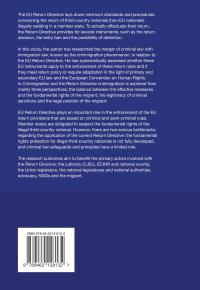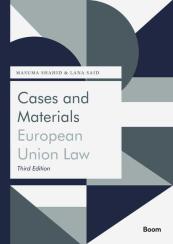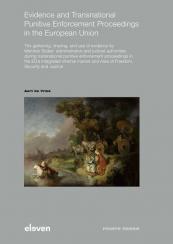Crimmigration and the Return Directive
Fundamental rights, criminal sanctions and the legal position of the migrant
Minimumnormen voor terugkeer van derdelanders
De EU-Terugkeerrichtlijn stelt minimumnormen en procedures vast met betrekking tot de terugkeer van onderdanen van derde landen (niet-EU-onderdanen) die illegaal in een lidstaat verblijven. Om hun terugkeer daadwerkelijk te realiseren, voorziet de Terugkeerrichtlijn in verschillende instrumenten, zoals het terugkeerbesluit, het inreisverbod en de mogelijkheid van detentie.
Crimmigratie en de EU-Terugkeerrichtlijn
In dit Engelstalige onderzoek heeft de auteur de vermenging van strafrecht en immigratierecht, ook wel crimmigratie genoemd, onderzocht in relatie tot de EU-Terugkeerrichtlijn. Hij heeft systematisch beoordeeld of deze EU-instrumenten toepasbaar zijn op de handhaving van deze terugkeerregels en of ze voldoen aan het terugkeerbeleid, of dat ze aanpassing vereisen in het licht van primair en secundair EU-recht en het Europees Verdrag voor de Rechten van de Mens. In Crimmigration and the Return Directive wordt crimmigratie vanuit drie perspectieven onderzocht: de balans tussen effectieve maatregelen en de fundamentele rechten van de migrant, de legitimiteit van strafsancties en de juridische positie van de migrant.
Handhaving van terugkeerregels en fundamentele rechten van migranten
De EU-Terugkeerrichtlijn speelt een belangrijke rol bij de handhaving van de EU-terugkeerbepalingen die gebaseerd zijn op strafrechtelijke en semi-strafrechtelijke regels. Lidstaten zijn verplicht de fundamentele rechten van derdelanders die illegaal verblijven, te respecteren. Er zijn echter twee ernstige knelpunten bij de toepassing van de huidige Terugkeerrichtlijn: de bescherming van fundamentele rechten voor illegale derdelanders is nog niet volledig ontwikkeld, en strafrechtelijke waarborgen en principes spelen een beperkte rol.
Belangrijke actoren Terugkeerrichtlijn
De uitkomsten van het onderzoek zijn bedoeld om ten goede te komen aan de belangrijkste actoren die betrokken zijn bij de Terugkeerrichtlijn: de rechterlijke macht (Hof van Justitie van de Europese Unie, Europees Hof voor de Rechten van de Mens en nationale rechtbanken), de wetgevende macht van de Unie, de nationale wetgevers en nationale autoriteiten, belangenorganisaties, ngo’s en de migrant.
Minimum standards for return third-country nationals
The EU Return Directive lays down minimum standards and procedures concerning the return of third-country nationals (non-EU nationals) illegally residing in a member state. To actually effectuate their return, the Return Directive provides for several instruments, such as the return decision, the entry ban and the possibility of detention.
Criminal law and immigration law
In this study, the author has researched the merger of criminal law with immigration law, known as the crimmigration phenomenon, in relation to the EU Return Directive. He has systematically assessed whether these EU instruments apply to the enforcement of these return rules and if they meet return policy or require adaptation in the light of primary and secondary EU law and the European Convention on Human Rights. In Crimmigration and the Return Directive crimmigration is explored from mainly three perspectives: the balance between the effective measures and the fundamental rights of the migrant, the legitimacy of criminal sanctions and the legal position of the migrant.
Enforcement and fundamental rights of migrants
EU Return Directive plays an important role in the enforcement of the EU return provisions that are based on criminal and semi-criminal rules. Member states are obligated to respect the fundamental rights of the illegal third-country national. However, there are two serious bottlenecks regarding the application of the current Return Directive: the fundamental rights protection for illegal third-country nationals is not fully developed, and criminal law safeguards and principles have a limited role.
Important actors EU Return Directive
The research outcomes aim to benefit the primary actors involved with the Return Directive: the judiciary (CJEU, ECtHR and national courts), the Union legislature, the national legislatures and national authorities, advocacy, NGOs and the migrant.








